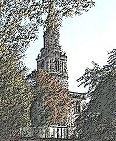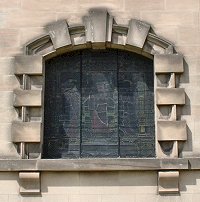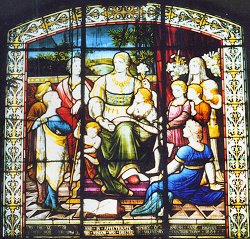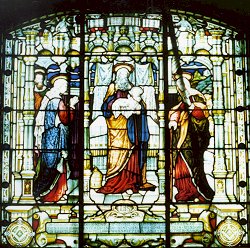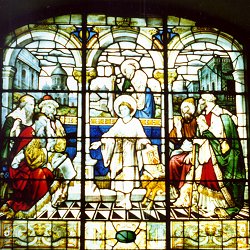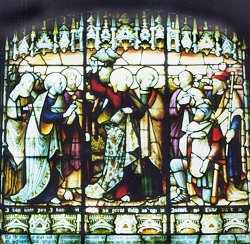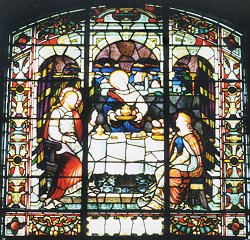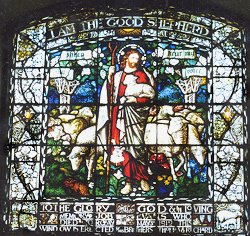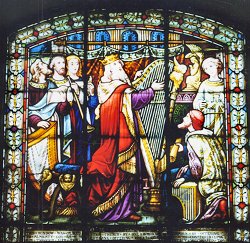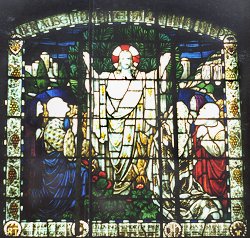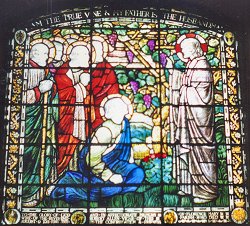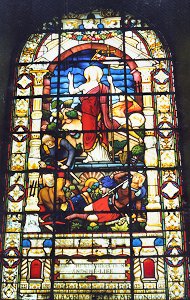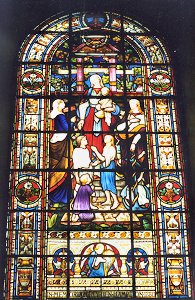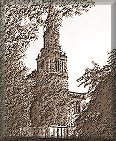The Windows
St John's church contains thirteen colourful late 19th and early 20th Century stained glass windows of good quality. As a result of some research into the records of St John's, the Wolverhampton Borough archives and the Stafford Record Office, it has been possible to discover the identities and something of the lives of those persons in whose memory these windows were installed. However, the more deeply one seeks to penetrate the past, the more illumination is required! An increasing number of questions arise, some of which can only be partially answered. No doubt many will have to remain altogether unanswered, at least for the present. Unless the reader can supply the information -which will be most gratefully received! Since this section was first written, in 1992, St John's has had restoration work carried out to the windows on the North side of the Church and this is being followed by restoration work on the South side. The craftsman involved is Mr Steve Robey of Dudley. In this work we have been assisted by a generous grant from Wolverhampton Town Council and money raised by the Friends of St John's Church. This will ensure that the windows will continue to enhance the beauty of the Church 'Into the Future'. The generous gift by Miss Mary Birnie, given in memory of her sister, Mrs. Joyce Careless, paid for the restoration of the windows in the North Aisle. A Wall Plaque is to be placed on the wall in recognition of this gift. The photos, when reproduced for the Internet, cannot hope to do justice to the windows; but they will serve as an aid to identification for the visitor. Introduction The Parish Church of St John the Evangelist, Wolverhampton was built in 1760. It is a typical 'Palladian' church of the Georgian period having a basilica format in which nave and choir are combined in a rectangular building with the sanctuary forming a square apse. The two side chapels are not consistent with the original design and the choir seating was at the rear of the church upstairs next to the organ. In contrast to the 'Gothic' churches of former periods it was well endowed with twenty-four large clear glass windows. These are on two levels lighting the gallery and aisles. For the first hundred years these windows were glazed in clear glass as are most of those in the gallery today. During the middle 19th Century the fashion in ecclesiastical buildings under the influence of architects such as A.W.N. Pugin and Gilbert Scott reverted to neo-gothic. Coloured glass windows became the vogue and many of the wealthier parishioners gave windows as memorials. Many of these have considerable artistic merit and are worthy additions to a place of worship. St John's church has thirteen such windows installed between 1852 and 1911. The remaining eleven clear windows still provide sufficient light (except in the Kilby Chapel) to give the church that light airiness which is characteristic of Georgian churches and is, in the cycle of fashion, very acceptable today. The inspection of the windows begins with the oldest windows in the sanctuary and then carries on clockwise, with the two largest windows in the gallery completing the tour. 1. Sanctuary, north side
Description: This is the first of a pair of windows depicting the Six Acts of Mercy. Matthew 25 v.35-36. The medallions show compassion for the hungry, the thirsty, the stranger. Artist: not known Inscription:
Plate on cill
Davenhills were wine and spirit merchants in Lichfield Street. Their premises are shown on early photographs and pictures standing where Barclays Bank is now, on the corner of Lich Gates passage. Their residence was in Tettenhall Wood. Isaac Scott's father, William Scott and his uncle Benjamin are shown in the Wolverhampton Directory for 1770 as Brassfounders in business at New Street. This street disappeared when Lichfield Street was extended to Railway Street. Their brother John was a shoemaker and barber in Goat Street (North Street). In 1793 Isaac was trading as an Ironmonger and Factor. The 1802 Rate Book gives his address as 13 Queen Street. Isaac had an elder brother, John, who took over the Brassfounding situated at that time at 3 Horseley Field. Uncle Benjamin had three sons. These were Isaac's cousins. John who had emigrated to Philadelphia but returned to become and Ironmonger in Birmingham. The other two, George and James were in partnership as Brassfounder, in Berry Street. However in 1817 James was Brassfounding at, 11 Queen Street, but George described himself in the Commercial Directory as "a maker of curious bell cranks and warrented hinge door springs"! In 1816, the year of Isaac's death, he was a merchant and factor in Snow Hill. Plaque on wall
John Roper, a solicitor, was for many years a Warden of St John's and Chairman of the Governors of Wolverhampton Grammar School. His wife and family had these windows restored by Steve Robey of Dudley and W Hipwood of Wolverhampton. 2. Sanctuary, south side
Description: This window depicts: naked and you clothed me - I was sick and you visited me - I was in prison and you came to me. This is Matthew 25 v 36. Inscription:
The top medallion was destroyed by vandals in 1988 and was replaced by Mr Robey, working from photographs. The date of this pair of windows is interesting. 1852 is not long after the rediscovery of 'antique glass'. See conclusion at the end of this page. Plate on cill
3. Window in St. Paul's Chapel This window is clear glass. The window which is at present at position 10 was originally installed here. Was it moved when the chapel was used as a choir vestry? It can be seen that the glass is modern and quite different from that which is in the gallery windows. 4. Second window on the south side
Description: Wisdom and her children. The central figure is that of a woman on whose knee is a scroll. She is surrounded by a group of children listening to her teaching. The lesson would appear to be 'Consider the lilies'. Artist: Ward & Hughes, London. Inscription:
Miss Higham lived at 1 Faulkland Street. She had two sisters and three brothers. An appreciation of her charitable work is given at length in the Magazine for 1884. She died 9th December 1883, aged 59. As a memorial to Sarah Higham there had been 'a hope that the sum of £300 might be raised with the object of erecting a Mission Room in the neighbourhood of Pountney Street, the district on which the deceased lady bestowed so much of her loving care'. It was believed that the people there found 'the service ,if the Mission Room appeals more than does the more elaborate one of the church'. Sadly the subscription did not reach the needed figure. It was decided instead, 'that the memorial take the form of a stained glass window'. In April the Parish Magazine records:- 'An unpretending wooden erection' has now passed into the hands of the church. It is proposed to use it as a Mission Room for Sunday and Weekday services, for Bible classes, temperance meetings etc. Cost of renting, lighting, heating and cleaning about £25 pa with £10 to £15 for renovating. 5. Third window on the south side
Description: Simeon in the Temple. Anna is on the right, Joseph and Mary on the left. 'Lord now lettest thou thy servant depart in peace'. Masonic symbols well in evidence. Artist: not known Inscription:
George Higham was the second son of George and Esther Higham. His grave stone is to be found by the north wall of the churchyard. It is inscribed "Died January 20th 1893 aged 75 years". He was in partnership with his brother Frederick (1823-1899) in a building concern in Castle Street. A contemporary advert declares that they made marble chimneypieces, table and washstand tops, fonts, monuments, headstones, wood mouldings. All were prepared by machinery run from steam power! G & F Higham were responsible for the restoration work in 1865-1869 at St John's. They also did extensive work at St Peter's, the rebuilding of the West doorway and surround. He lived in Waterloo Road. 6. Fourth window on the south side
Description: The boy Jesus in the temple. Artist: Signed by, G A Baguley. Inscription: There is no inscription. This window was purchased with money subscribed for the previous window to George Higham. 7. Fifth window on the south side
Description: Jesus with the Centurion. 'I say unto you I have not found as great a faith, no, not in all Israel' Luke 7:9 Artist: S Evans, West Smethwick Inscription:
Corporal William Garfield was the eldest son of William Garfield, wholesale corn factor and flour sellers of 1&2 Worcester Street. His father was at one time a Warden of the church. Express & Star, Friday 25th May, 1900: "Pretoria May 22. The Landrost of Vryheid report that about sixty British cavalry on Sunday afternoon came into collision with eighty men of the Swaziland Commando under Commandant Blignant at Scheepers Nek, with the result that only about twenty British escaped. Thirteen men including one lieutenant and two subalterns were taken prisoner. Of the twenty British who escaped some were wounded. The Federal losses were one Swaziland Burgher killed and one slightly wounded. -- The exact figures of the British casualties were 27 killed, 25 wounded and 11 taken prisoner. The loot included 25 horses, 2 maxims and ammunition. The Federals assisted in removing the wounded and burying the dead". William Garfield went out to South Africa in 1893, and shortly after arrival obtained the appointment as secretary of the Ferreira Deep Mining Corporation of Johannesburg. On the out break of war he, with many other 'Uitlanders' had to clear out of the Transvaal. He went first to Lorenco Marques and from there to Durban, where he joined Colonel Bethune's Corps of Mounted Infantry. He was present on duty by the Naval guns at the battle of Colenso, but escaped unharmed. Had he lived another six days be would have celebrated his 31st birthday, and probably taken part in the entry of Lord Roberts into Pretoria. 8. Fifth window on the north side
Description: Jesus in the house of Martha and Mary. Artist: Camm and Co, Smethwick. Inscription:
Jane Evans was 73 at her death on 24th August at Mound Braddon, Torquay. She and her husband lived at The Fordhouse, Wolverhampton and were prominent members of St John's. When Job Evans retired from business they lived for a short time at Hammerwich near Lichfield, later moving to Torquay. 9. Fourth window in the north side
Description: I am the Good Shepherd and my sheep hear my voice. Artist: Camm & Co Smethwick. It is signed 'Executed by Florence Camm, Robert Camm for Thomas William Camm. The studio, Smethwick'. Inscription:
Job Evans and his wife were generous to many charities, and Job's name heads the 1880 list of the Renovation fund, with a gift of ten guineas. He was a partner in the firm of Pinson and Evans, 21 Melbourne Street. This firm was engaged in the business of manufacturing corrugated galvanised iron roofing sheets and stamped holloware. Wolverhampton at that time was a large producer of these sheets, some 6,000 men being employed in the area. Other factories included, S J & E Fellows Ltd.; J & E Walker, Princes End,Tipton; Wolverhampton Corrugated Iron Company, Church Lane; John Lysaught; Edward Davis, Snow Hill; G Adams & Sons; Edward Perry, Merridale Street; and others Galvanising was a French invention and was brought to England by a Mr Crawford in 1837. In that year he took out a patent for roofing sheets. It was seen that these sheets were ideal for the great woolsheds of Australia, New Zealand and South America; but the colonists looked with suspicion at the new sheets and kept to their old wooden shanties. Also there was the growing railway system and sheets were tried on the roofs of stations. Unfortunately the corrosive smoke and steam destroyed the metal and the enthusiasm of the railway authorities waned. However after a long period of patient endeavour, both the railways and the colonial market became convinced of the advantages of the new lightweight and durable material and the orders came in quantity. 10. Third window on the north side
Description: 'To God be the glory'. King David providing instruction to an attentive audience of musicians. Why would his crown have the fleur-de-lys? Artist: Ward Hughes, London, 1882. Inscription:
This window was presented by Moses Ironmonger. The circumstances of the great mercy remains a mystery, especially to his great grand daughter. Moses' father, Aaron Ironmonger, died in 1827 leaving Moses at the age of 18 'with few friends and less wealth'. He took up the family business of rope making and soon established a thriving business in Cock Street (now Victoria Street). His wife, Mary Perry, died in 1836, leaving him with two small sons. He remarried in May 1841, Elizabeth Bosworth, by whom he had two daughters. Moses' business prospered and he occupied an extensive factory in Brickkiln street, on the corner of Alexandra Street. In recent years this was occupied by Baynell's. The buildings incorporated a temporary chapel once used in London by Charles Spurgeon, the great Baptist preacher. Moses Ironmonger was much taken up by municipal affairs and became a County magistrate and Town Councillor. In 1857-8, and again in 1868-9, he served as Mayor of Wolverhampton. His residence at the time of his death was given as Graiseley Hill. The encaustic pavement round the font was given to the church by Mr Ironmonger at the time of the restoration of 1869. 11. Second window in the north side
Description: Jesus in a garden blessing his followers. The text reads, 'Because I live ye shall live also'. John 14:19. This is taken from the account of the last supper. Artist: The Bromsgrove Guild. Inscription:
John Higham was the eldest son of George and Esther Higham. He lived 1807-1843. He was brother to Sarah and George. The sons were George1835-1872 and John 1840-1918. 12. First window on the north side
Description: Jesus with his disciples. The text is 'I am the true vine and my Father the husbandman' Artist: Archibald Davies of the Bromsgrove Guild. Inscription:
Robert Allen, a Cambridge MA, was ordained Deacon in 1894. He was appointed Curate of Christ Church, West Bromwich, from 1894-1902, when he became Vicar of St John's. He served here until 1924 when he moved to become Vicar of Bradeley near Stafford, where he remained until 1928. In 1910 the population of St John's parish was 5296 and was confined to the immediate precincts of the church. (The present parish includes what was, at that time, St Paul's parish). It will be seen that it was a densely occupied parish. The curate was Rev A R Goodwin BA and the Wardens Mr Alfred Hall and Mr Samuel Glaze. There were Sunday services, 8 am. 11 am. 3.30 pm. and 6.30 pm. At that time St John's had a Day School in Cleveland Street some of the records are still in the archives. The Headmaster was Mr H J Doughty and the Mistress was Miss E Perks. The report on the Easter services said that these had been well attended, there being nearly 400 communicants. While it was the largest for seven years it was believed it could have been larger! It would seem that at this period the church was one of the most flourishing in the Town. 13. Gallery on the south and north sides
Gallery south side: Description: The risen Lord in the garden with sleeping soldiers. The text is 'I am the resurrection and the life' Inscription:
Gallery north side: Description: Faith Hope and Charity Inscription:
Henry Hampton was Vicar of St John's 1862-1880. During this time there was a rapid expansion of this part of the town and Rev Hampton had a hard task in the parish. He was born 1st January 1804 at Longdon in Herefordshire and was admitted Deacon, at the age of 23, by Bishop John Banks, Bishop of St David's, and licensed as curate at Llanavanvechan. In 1837 he was licensed by the Bishop of Hereford to the living of Acornbury. The following year he was given the plural living of Rector of Little Birch. He remained there until 1850 when he accepted another challenge and was licensed, this time by the Bishop of Chester, to be Perpetual Curate of St Jame's at Walton on the Hill, Liverpool. Here he found the church in a most dilapidated condition but, by his energy and earnestness, he effected not only the restoration of the church but also that of the schools. In 1855, at the age of 51, he moved to London and took charge of a mission district called 'Pococks Fields' in Islington. Here he set about building an entirely new church, St Luke's, Holloway and was appointed its first incumbent. He moved yet again in 1862, exchanging his living with Rev Edward Pizey, and moving to St. John's, Wolverhampton. He was instituted on 19th May 1862. Here he stayed until at the good old age of 76. He died at the vicarage, having been the vicar for 18 years and a minister of Christ for 56 years. Henry Hampton found the school buildings in a deplorable condition and put in hand an immediate restoration at a considerable cost. When finished they were said to be superior to any in the neighbourhood. This human dynamo then established a Mission Church in Steelhouse Lane which backed on to Rough Hills, at that time a brickfield and colliery. Here he founded both church and schools. The Rev. Hampton then took into his care the major restoration work carried out on the church in 1869. He next turned his attention to his Steelhouse Lane work and in 1877 commenced the new Church of All Saints. After many trials and much anxiety All Saints was opened on 1st November 1879. Henry Hampton died after an illness of only a few days in April the following year, at the age of 76. The seat holders of St John's met shortly after his death and agreed that 'It is desirable to erect some memorial to the late Vicar and that it should take the form of two stained glass windows and a fitting Tablet.' A substantial sum was very quickly raised and it was hoped that the windows could be installed in the East end of the Church building. Drayton Wyatt was asked to urgently submit a design for altering the masonry to that purpose. By June it was apparent that there was sufficient money to commission two windows from Messrs. Gibbs of London at a cost of a little over £200. However any hope of installing them in the apse was short lived. The funds were quite inadequate for that scheme. Consequently these windows were placed at the east end of the north and south walls in the gallery. This makes them hard to see, yet at that time there were no other stained glass windows in the Church except those in the apse. It is probable that this was felt more suitable than having the disappointment of both reducing the size and changing the designs to smaller windows than at first planned. Whether the Architect was disappointed that his scheme was not carried out is not recorded. The central circular window and exterior embellishments might be described unkindly as 'curious'. But fashions change, as Mr J. Drayton Wyatt himself had once observed! Conclusion Making pictorial windows in coloured glass is essentially a Christian art form, its popularity stemming from the medieval belief in a relationship between light, glass, and the Spirit of God. Thus the glazing of the earliest Christian churches was regarded as far more significant than mere weather proofing. Although the medieval windows in English churches are usually said to contain 'stained glass', it would be more accurate to describe it as 'painted glass'. The colours of a medieval window run right through the entire thickness of the glass and were imparted by the addition of metal oxides to the glass mix in its molten state. Such glass is known as 'pot metal'. The details of features, drapery and decoration were all painted on to the surface of the coloured glass and then chemically combined with the glass body by firing in a kiln. In all stained glass work of the early 19th century the achievement of an authentic medieval effect (both in new, and in the restoration of earlier, windows) was limited by two factors: the quality of the glass available and an imperfect understanding of the historical styles. The technical problems were solved mainly through the efforts of an amateur glass student, Charles Winston (1814-65). In 1849 he arranged the successful chemical analysis of medieval glass. He next persuaded the firm of James Powell & Son of Whitefriars Glassworks, London, to manufacture 'antique' glass. They was soon to be followed by W. E. Chance of Birmingham. It was this latter local source of material which led to the setting up of stained glass window studios in the Birmingham area. The 1840s were also to witness the publication of a number of written works on historical styles. So by the time of Pugin's death in 1852, the heritage of medieval glass was to rest in the hands of men whose style and technical skills approached and sometimes even surpassed that of the medieval masters. In 1835 the Ecclesiastical Commissioners embarked upon a plan of extensive church building in response to the enormous development in new urban areas which were ill served by existing churches. The 1850s saw the emergence of a new generation of Gothic revival architects. As a consequence, by 1860, stained glass had experienced a substantial revival. In England in particular it had been restored to a position of prominence in the decorative arts and the craft had become dominated by a stylish historicism, in which the champions of the thirteenth to sixteenth centuries argued for their particular style. The most prolific firms turned to a quasi-industrial mass production in order to meet the massive demand for their products. It was against this background that William Morris and his circle were to introduce a truly original expression, with an idiom which rejected a slavish archaeological imitation of Gothic. This 'Arts and Crafts' influence is seen in the two Bromsgrove Guild windows (nos. 11 & 12). It is also interesting to compare the two Camm windows (nos 8 & 9). The 1910 window is clearly in the "traditional" style by the firm still headed by T. W. Camm, who was to die in 1912. His daughter, Florence Camm, trained at the Birmingham College of Art and then, aged about 38, took over as the principal artist. Her two brothers ran the business. Her 'Good Shepherd' window of 1912 shows all the exuberance of the creative "Arts and Crafts" phase in the history of English Stained Glass. |
|||||
